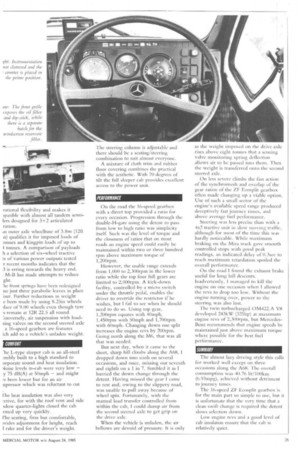PERFORMANCE On the road the 16-speed gearbox with a direct
Page 27

If you've noticed an error in this article please click here to report it so we can fix it.
top provided a ratio for every occasion. Progression through the double-H-gate using the detem to pass from low to high ratio was simplicity itself. Such was the level of torque and the closeness of ratios that on most roads an engine speed could easily be maintained within two or three hundred rpm above maximum torque of 1,20Orpm.
However, the usable range extends from 1,000 to 2,300rpm in the lower ratio while the top four full gears are limited to 2,000rpm. A kick-down facility, controlled by a micro switch under the throttle pedal, enables the driver to override the restrictor if he wishes, but I fail to see when he should need to do so. Using top gear, 1,200rpm equates with 40mph, 1,450rpm with 50mph and 1,700rpm with 60mph. Changing down one split increases the engine revs by 200rpm, Going north along the M6, that was all that was needed.
But next day, when it came to the short, sharp hill climbs along the A68, I dropped down into sixth on several occasions, and once, missing out seventh and eighth on a 1 in 7, iiimbled it as I hurried the down change through the &tent. Having missed the gear I came to rest and, owing to the slippery road, was unable to pull away because of wheel spin. Fortunately, with the manual load transfer controlled from within the cab, I could dump air from the second steered axle to get grip on the drive axle.
When the vehicle is unladen, the air bellows are devoid of pressure. It is only as the weight imposed on the drive axle rises above eight tonnes that a sensing valve monitoring spring deflection allows air to be passed into them. Then the weight is transferred onto the second steered axle.
On less severe climbs the fast action of the synchromesh and overlap of the gear ratios of the ZF Ecosplit gearbox often made changing up a viable option. Use of such a small sector of the engine's available speed range produced deceptively fast journey times, and above average fuel performance.
Steering was less precise than with a 4x2 tractive unit in slow moving traffic, although for most of the time this was hardly noticeable. While maximum braking on the Mira track gave smooth controlled stops with good peak readings, an indicated delay of 0.3sec to reach maximum retardation spoiled the overall performance.
On the road I found the exhaust brake useful for long IA descents. Inadvertently, I managed to kill the engine on one occasion when I allowed the revs to drop too low. Without the engine turning over, power to the steering was also lost.
The twin turbocharged 0M422.A V8 developed 243kW (325hp) at maximum engine revs of 2,300rpm, but MercedesBenz recommends that engine speeds be maintained just above maximum torque where possible for the best fuel performance.




































































